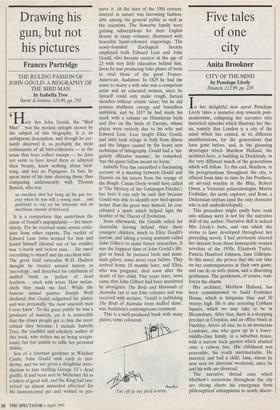Drawing his gun, but not his pictures
Frances Partridge
THE RULING PASSION OF JOHN GOULD: A BIOGRAPHY OF THE BIRD MAN by Isabella Tree Barrie & Jenkins, £16.99, pp. 250 Here lies John Gould, the "Bird Man" ' was the modest epitaph chosen by the subject of this biography. It is an ambiguous description, and though he cer- tainly deserved it, as probably the most enthusiastic of all bird-collectors — in the sense that boys collect stamps — he does not seem to have loved them or admired their beauty, knew nothing about bird- song, and was no Papageno. In fact, he spent most of his time shooting them, thus comparing unfavourably with Thomas Bewick, who was
an excellent shot but hung up his gun for- ever when he was still a young man. . . and preferred to rely on his telescope and an inordinate amount of bird-seed.
It is a comparison that underlines the cause of Gould's unpopularity — his insen- sitivity. For he received some severe critic- isms from other experts. The verdict of Edward Lear (who worked for him and found himself cheated out of his credits) was 'a harsh and violent man. . . He owed everything to myself and his excellent wife.' The great field naturalist W.H. Hudson thought he treated natural history as `necrology', and described his exhibition of stuffed birds as 'pellets of dead feathers. . . stuck with wires. How melan- choly they made me feel.' While the famous animal painter Joseph Wolf declared that Gould vulgarised his plates, and was personally 'the most uncouth man I ever knew'. To the great public he was a producer of marvels, yet it is noticeable that the closer people got to him the more critical they become. I include Isabella Tree, the youthful and scholarly author of this book, who strikes me as being scrupu- lously fair but unable to stifle her personal dislike.
Son of a foreman gardener at Windsor Castle, John Gould took early to taxi- dermy, and we are given a delightful intro- duction to him stuffing George IV's dead giraffe. It had been sent by Mehemet Ali as a token of good will, and the King had con- ceived 'an almost immodest affection' for his lustrous-eyed pet and wished to pre- serve it. At the start of the 19th century, interest in nature was becoming fashion- able among the general public as well as the scientists. The Sowerby family were gaining subscriptions for their English Botany in many volumes, illustrated with beautiful hand-coloured engravings. The newly-founded Zoological Society employed both Edward Lear and John Gould, who became curator at the age of 23 with very little education behind him. Soon he was producing folio plates of birds to rival those of the great Franco- American, Audubon. In 1829 he had the sense to marry a wife who was a competent artist and an educated woman, since he himself could only make rough, factual sketches without artistic value; but he did possess stubborn energy and boundless ambition, and by 1837 he had made his mark with a volume on Himalayan birds and five on the birds of Europe, whose plates were entirely due to his wife and Edward Lear. Lear taught Eliza Gould, and later took refuge in Italy from illness and the fatigue caused by the heavy new technique of lithography. Gould had a 'sin- gularly offensive manner', he remarked, `but the queer fellow meant no harm.'
Isabella Tree has unearthed a fascinating account of a meeting between Gould and Darwin on his return from the voyage of the Beagle. Conan Doyle would have called it 'The Mystery of the Galapagos Finches'; but here it can only be said that because Gould was able to identify new bird-species better than the great man himself, he con- tributed a spark which helped light the bonfire of the Theory of Evolution.
Soon afterwards, the Goulds sailed for Australia, leaving behind their three youngest children, much to Eliza Gould's sorrow, and taking a young assistant called John Gilbert to make future researches. It was the happiest time of John Gould's life: gun in hand, he pursued birds and mam- mals galore, some never seen before. They arrived home 18 months later, and Eliza, who was pregnant, died soon after the death of her child. Five years later, news came that John Gilbert had been murdered by aborigines. The Birds and Mammals of Australia ran to ten folio volumes and was received with acclaim. 'Gould is publishing The Birds of Australia from stuffed skins', was Audubon's contemptuous comment.
This is a well-produced book with many plates, some coloured.
"m off to my pied-a-terre.'


















































 Previous page
Previous page